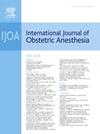Changes in velocimetric indices of uterine and umbilical arteries before and after combined spinal epidural analgesia in laboring women: a prospective cohort study
IF 2.3
3区 医学
Q2 ANESTHESIOLOGY
引用次数: 0
Abstract
Background
Although combined spinal epidural (CSE) analgesia is an effective technique for labor analgesia, concerns regarding fetal bradycardia still remain. Increased vascular resistance of the uterine (UtA) and/or umbilical arteries (UmA) after CSE could explain the reported occurrence of fetal bradycardia. The aim of this study was to assess the changes in the resistance of UmA and UtA before and after initiation of CSE labor analgesia using ultrasound Doppler pulsatility index (PI).
Methods
This was a prospective, observational study in singleton, full-term laboring participants. Doppler ultrasound PI of the UtA and UmA were obtained before and after CSE at 10 and 30 min. The primary outcome was PI at 10 min. The differences in indices were analyzed using paired t-tests or Wilcoxon signed-rank tests, and mixed models were used in the exploratory analyses to assess changes over time.
Results
Data were analyzed for 30 participants. Compared to baseline, there was a significant increase in mean UtA PI (Δ 27 %, P = 0.029) at 10 min, however no significant difference was observed in the UmA PI. UtA PI showed a significant increase over time (coefficient 0.05, P = 0.002), while no changes were observed in UmA PI or fetal heart rate.
Conclusion
Our study suggests that CSE for labor analgesia may be associated with a discrete increase in maternal UtA resistance, however, these changes are not reflected in UmA resistance in the fetus, providing reassurance that CSE with low-dose local anesthetic is a safe analgesic technique in labor.
分娩妇女脊髓硬膜外联合镇痛前后子宫和脐动脉流速指标的变化:一项前瞻性队列研究
背景:尽管脊髓硬膜外联合镇痛(CSE)是一种有效的分娩镇痛技术,但对胎儿心动过缓的担忧仍然存在。CSE后子宫(UtA)和/或脐动脉(UmA)血管阻力的增加可以解释胎儿心动过缓的发生。本研究的目的是利用超声多普勒脉搏指数(PI)评估CSE分娩镇痛开始前后UmA和UtA阻力的变化。方法:这是一项前瞻性观察性研究,研究对象为单胎足月分娩参与者。分别于CSE术前和术后10、30 min分别获得UtA和UmA的多普勒超声PI。主要终点是10分钟时的PI。使用配对t检验或Wilcoxon符号秩检验来分析指标的差异,并在探索性分析中使用混合模型来评估随时间的变化。结果对30名参与者进行数据分析。与基线相比,10分钟时平均UtA PI显著增加(Δ 27%, P = 0.029),但UmA PI无显著差异。UtA PI随时间显著升高(系数0.05,P = 0.002),而UmA PI和胎心率未见变化。结论本研究提示,CSE用于分娩镇痛可能与母体对UtA耐受性的离散性增加有关,但这些变化并未反映在胎儿对UmA的耐受性上,这再次证明CSE联合小剂量局麻是一种安全的分娩镇痛技术。
本文章由计算机程序翻译,如有差异,请以英文原文为准。
求助全文
约1分钟内获得全文
求助全文
来源期刊
CiteScore
4.70
自引率
7.10%
发文量
285
审稿时长
58 days
期刊介绍:
The International Journal of Obstetric Anesthesia is the only journal publishing original articles devoted exclusively to obstetric anesthesia and bringing together all three of its principal components; anesthesia care for operative delivery and the perioperative period, pain relief in labour and care of the critically ill obstetric patient.
• Original research (both clinical and laboratory), short reports and case reports will be considered.
• The journal also publishes invited review articles and debates on topical and controversial subjects in the area of obstetric anesthesia.
• Articles on related topics such as perinatal physiology and pharmacology and all subjects of importance to obstetric anaesthetists/anesthesiologists are also welcome.
The journal is peer-reviewed by international experts. Scholarship is stressed to include the focus on discovery, application of knowledge across fields, and informing the medical community. Through the peer-review process, we hope to attest to the quality of scholarships and guide the Journal to extend and transform knowledge in this important and expanding area.

 求助内容:
求助内容: 应助结果提醒方式:
应助结果提醒方式:


